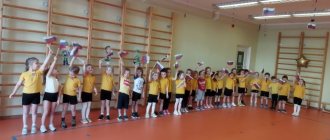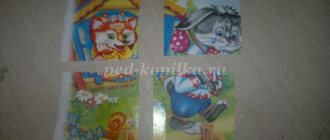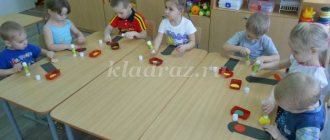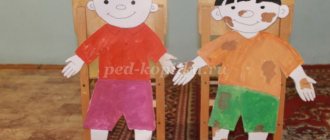Summary of physical education activities for the younger group of kindergarten “We have a round ball”
Summary of physical education for the younger group “We have a round ball”
Goal: Learn to play with the ball, develop motor activity.
Previous work: Morning exercises using a ball, physical education with a ball, outdoor games with a ball. Attributes: Medium and small balls for all children, a basket for throwing balls. Progress of the entertainment: The teacher brings two baskets of balls into the group and places them on the floor. Play
: Today we have a ball festival, and I brought you so many balls!
Game “Find Yourself a Ball”
I will raise the balls high, high!
The balls will fly far, far away! Our children will run and find balls for themselves! (At the end of the words, the teacher throws the balls up so that they scatter in different directions. Children must quickly collect them back into the basket. The game continues 2-3 times) Play
.
Guys, we still have balls, and they are larger. How can we play with them? (The teacher pours medium-sized balls out of the basket, the children take one ball for themselves, one ball for the teacher). Game “Catch, throw.
" Catch it, throw it, don't let it fall!
"(Throwing balls up) "Catch, push, don't let you fall! "(Throwing a ball on the floor and catching it) Play.
: Let our balls rest, but one, the funniest one, still wants to play with us some more.
Let's play with him some more. Game “Ball in a Circle”
(Children sit in a circle on the floor. The teacher suggests rolling the ball away from each other, pushing it with both hands.)
Game “Don’t be angry - smile!
“ Children stand in a circle at a distance of one step from each other and pass the ball to each other with the words: “Don’t be angry, smile!”
» Playback
: This ball is tired too, it’s time for him to go home.
(The teacher takes away the balls). Good children, skillful children, you are the best children in the world. I've got something for you. I brought balloons for you. Physical education.
Physical education is one of the most effective forms of active recreation.
Its content consists of physical exercises, which are carried out in the form of fun games, fun, and entertainment. Exercises performed with emotional upliftment have a beneficial effect on the child’s body. During physical education, children’s motor skills are consolidated and motor qualities (speed, dexterity, spatial orientation, etc.) are developed. Physical education leisure activities contribute to the development of a sense of collectivism, camaraderie, friendship, mutual assistance, develop endurance and attention, dedication, courage, perseverance, discipline and organization. Pedagogical requirements for the organization and conduct of physical education.
Physical education is carried out in all age groups, starting from the second youngest, once or twice a month. In the junior and middle groups for twenty to thirty minutes, in the senior group - thirty-five to forty minutes, in preparatory school - forty to fifty minutes. They are organized in the afternoon, after afternoon tea, mainly in the open air (in inclement weather in the hall). During the holidays, as well as in the summer, physical education can be carried out in the first half of the day, after breakfast. When planning leisure activities, it is necessary to take into account such forms of work as a “health day”, a physical education holiday, and vacations. You should not conduct physical education activities on days designated for physical education activities. It is most convenient to spend leisure time with students of the same age group, especially in primary and secondary preschool age. However, it is permissible to combine two same-age and different-age groups. The effectiveness of this form of work depends on the active participation of each child. Adults should not forget that preschoolers tend to violently express their emotions, especially during games and relay races of a competitive nature. We must not allow children to become overexcited, but at the same time we must be sensitive to their emotional manifestations and not drown out their joyful mood with frequent and unjustified remarks. For example, a teacher, feeling that the children are starting to get overexcited, raises his hand or blows a whistle, pauses, and the children also calm down. Then the teacher in a quiet voice suggests continuing the game. When conducting physical education outdoors in different seasons of the year, children should be dressed appropriately. Physical education leisure can be organized on a sports ground, a kindergarten site, in natural conditions of the natural environment: in a meadow, in a forest, on the shore of the sea, river, lake, as well as indoors. When determining the theme and content of leisure, one should also take into account climatic conditions and national traditions of the local population. As already noted, physical education leisure does not require much organizational and preparatory work, however, the definition of its topics and the selection of content must be approached creatively. When conducting physical education leisure in different age groups, the teacher faces certain tasks: in early preschool age it is necessary to involve children in all possible participation in collective and individual motor actions, to enrich their vivid impressions. In middle preschool age, children are taught to independently participate in competitive exercises, games, and entertainment. At the same time, encourage each child to demonstrate their capabilities. In older preschool age, develop in children the ability to creatively use their motor experience in conditions of emotional communication with peers, teach them to take initiative in a variety of activities. The structure of physical education leisure depends on the topic, assigned tasks and conditions. Approximate scheme for constructing physical education leisure. Junior preschool age. 1. Inviting children to the sports ground. 2. Game tasks for the whole group (walk along the bridge, run like a snake between trees and bushes). 3. Outdoor game. 4. Surprise moment. 5. Performing general developmental exercises. 6. General group exercises in a variety of basic movements (walking and running on all fours, climbing a fallen tree). 7. Outdoor game. 8. Low mobility game.




